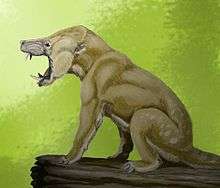Arctocyonidae
| Arctocyonidae Temporal range: Late Cretaceous - Eocene, 66–50 Ma | |
|---|---|
 | |
| Arctocyon | |
| Scientific classification | |
| Kingdom: | Animalia |
| Phylum: | Chordata |
| Class: | Mammalia |
| Family: | †Arctocyonidae Giebel, 1855 |
Arctocyonidae (from Greek arktos kyôn, "bear/dog-like") is an extinct family of unspecialized, primitive mammals with more than 20 genera. The family was most abundant during the Paleocene, but extant from the late Cretaceous to the early Eocene (66 to 50 million years ago). [1] These animals are thought to be the ancestors of the orders Mesonychia and Cetartiodactyla, although some morphological studies have suggested that Arctocyonidae is a 'wastebasket' group for basal ungulates, and is in fact, polyphyletic [2]
Characteristics
Arctocyonid skulls had large canines and relatively sharp teeth and were thus superficially similar to those of modern carnivores. However, arctocyanid teeth were not specialized for slicing meat; these animals were probably omnivorous and definitely the least herbivorous of the condylarths. Arctocyonid teeth show much individual variation and, because many members of this family are only known from fossil teeth, the taxonomy of the genera is highly unstable. [3]
They had relatively short limbs lacking the specializations associated with ungulates (e.g. reduced side digits, fused bones, and hoofs),[3] and long, heavy tails. Their primitive anatomy makes it unlikely that they were able to run down prey, but with their powerful proportions, claws, and long canines, they may have been able to overpower smaller animals in surprise attacks. [4]
Evolutionary variation
The arctocyonids were the most common mammals in Europe during the Paleocene. Archaic arctocyanids, such as Prolatidens, have been found in the early Paleocene layers in Hainin, Belgium. From there, this family evolved into a wide variety of genera, including Arctocyon (known as/similar to Claenodon in North America), Arctocyonides, Landenodon, and Mentoclaenodon, found in the late Paleocene layers of Cernay, France.[5]
A near-complete skeleton of the North American Chriacus, an early arctocyonid and also one of the smallest, has been found in Wyoming. This raccoon-like animal had powerful limb muscles and a long, robust, and maybe prehensile tail. Capable of both balancing in a tree and digging, it was adapted to both an arboreal and a terrestrial life.[3]
Larger arctocyonids spent most of their time on the forest floor, but were probably still able to climb trees. It can be assumed that they may have partly taken over the role of large predators in Paleocene faunas together with other similar groups, such as the triisodontids and mesonychids, two families traditionally classified as condylarths, but now assigned to the order Mesonychia.[3]
Large arctocyonids include:
Arctocyon features the characteristics of the entire family. This robust, bear-sized animal was a plantigrade ungulate with short limbs; its feet had claws and it had a long tail. It had a long skull equipped with a large sagittal crest and large canines, especially the lower ones. It had low-crowned, bunodont molars (i.e. teeth with rounded cusps) similar to modern bears, and it is assumed that they had a similar omnivorous diet. The related subfamily Arctocyonides were smaller and more slender.[5]
Mentoclaenodon was, judging from the scarce material available on the genus, larger than the other two large genera and tended to develop long canines similar to early big cats.[5]
Classification
Subfamilies and genera:[6] (incertae sedis)
- Arctocyonides Lemoine, 1891
- Arctocyonides weigelti Lemoine, 1891
- Carcinodon Scotti, 1892
- Carcinodon aquilonius
- Chriacus (syn. Epichriacus, Metachriacus, Spanoxyodon, Tricentes)
- Chriacus badgleyi
- Chriacus badwini
- Chriacus calenancus
- Chriacus gallinae
- Chriacus katrinae
- Chriacus metocometi
- Chriacus oconostotae
- Chriacus pelvidens
- Chriacus punitor
- Deuterogonodon
- Heteroborus
- Hyodectes
- Lambertocyon
- Landenodon
- Mentoclaenodon
- Mimotricentes
- Oxytomodon
- Paratriisodon
- Princetonia
- Prothryptacodon (syn. Pantinomia)
- Thryptacodon
- Loxolophinae
- Baioconodon (syn. Ragnarok)
- Loxolophus (syn. Paradoxodon, Paradoxodonta, Protochriacus, Protogonodon)
- Arctocyoninae
- Anacodon Cope,1882
- Anacodon cultridens Matthew,1915
- Anacodon nexus Gazin,1956
- Anacodon ursidens Cope,1882
- Arctocyon Blainville, 1841 (syn. Claenodon, Neoclaenodon)
- Arctocyon corrugatus (Cope,1883)
- Arctocyon ferox
- Arctocyon latidens
- Arctocyon montanensis
- Arctocyon mumak
- Colpoclaenus Patterson & McGrew,1962
- Colpoclaenus keeferi
- Colpoclaenus procyonoides
- Anacodon Cope,1882
See also
Notes
- ↑ Allaby, Michael (2003). A dictionary of zoology (2nd ed.). Oxford University Press. p. 42. ISBN 978-0-19-860758-8.
- ↑ Smith, De Bast. "Reassessment of the Small 'Arctocyonid' Prolatidens waudruae from the Early Paleocene of Belgium, and Its Phylogenetic Relationships with Ungulate-Like Mammals". Journal of Vertebrate Palaeontology. Retrieved August 2013. Check date values in:
|access-date=(help) - 1 2 3 4 Jehle, Martin. "Condylarths: Archaic hoofed mammals". Paleocene mammals of the world. Retrieved February 2010. Check date values in:
|access-date=(help) - ↑ Jehle, Martin. "Carnivores, creodonts and carnivorous ungulates: Mammals become predators". Paleocene mammals of the world. Archived from the original on 9 February 2010. Retrieved February 2010. Check date values in:
|access-date=(help) - 1 2 3 Agusti 2002, pp 11-13
- ↑ "Arctocyonidae". The Palaeobiology Database. Retrieved February 2010. Check date values in:
|access-date=(help) (Click link "View classification of included taxa")
References
- Agusti, Jordi; Anton, Mauricio (2002). Mammoths, Sabertooths, and Hominids: 65 Million Years of Mammalian Evolution in Europe. Columbia University Press. ISBN 0-231-11640-3.